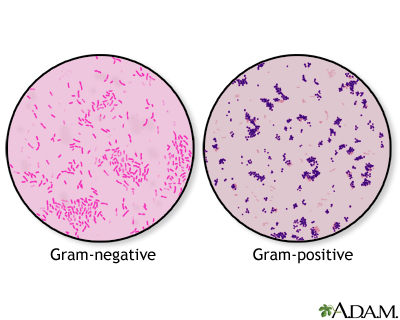Gram stain of urethral discharge
Urethral discharge Gram stain; Urethritis - Gram stain
A Gram stain of urethral discharge is a test used to identify bacteria in fluid from the tube that drains urine from the bladder (urethra).

The gram stain procedure is a method of staining microorganisms on a slide using crystal violet to be viewed later under a microscope.

A Gram stain is a test used to help identify bacteria. The tested sample can be taken from body fluids that do not normally contain bacteria, such as blood, urine, or cerebrospinal fluid. A sample can also be taken from the site of a suspected infection, such as the throat, lungs, genitals, or skin. Bacteria are classified as either Gram-positive or Gram-negative, based on how they color in reaction with the Gram stain. The Gram stain is colored purple. When combined with the bacteria in a sample, the stain will either stay purple inside the bacteria (Gram-positive), or it will turn pink (Gram-negative). Examples of Gram-positive bacteria include Streptococcus and Staphylococcus aureus, as well as bacteria that cause anthrax, diphtheria, and toxic shock syndrome. Examples of Gram-negative bacteria include Escherichia coli (E coli), Salmonella, Hemophilus influenzae, as well as many bacteria that cause urinary tract infections, pneumonia, or peritonitis.
How the Test is Performed
Fluid from the urethra is collected on a cotton swab. A sample from this swab is applied in a very thin layer to a microscope slide. A series of stains called a Gram stain is applied to the specimen.
The stained smear is then examined under the microscope for the presence of bacteria. The color, size, and shape of the cells help identify the type of bacteria causing the infection.
How to Prepare for the Test
This test is often performed in the health care provider's office.
How the Test will Feel
You may feel pressure or burning when the cotton swab touches the urethra.
Why the Test is Performed
The test is performed when an abnormal urethral discharge is present. It may be performed if a sexually transmitted infection is suspected.
Normal Results
Normal value ranges may vary slightly among different laboratories. Some labs use different measurements or test different samples. Talk to your provider about the meaning of your specific test results.
What Abnormal Results Mean
Abnormal results may indicate
Risks
There are no risks.
Considerations
A culture of the specimen (urethral discharge culture) should be performed in addition to the Gram stain. More advanced tests (such as polymerase chain reaction [PCR] tests) may also be done.
References
Babu TM, Urban MA, Augenbraun MH. Urethritis. In: Bennett JE, Dolin R, Blaser MJ, eds. Mandell, Douglas, and Bennett's Principles and Practice of Infectious Diseases. 9th ed. Philadelphia, PA: Elsevier; 2020:chap 107.
Swygard H, Cohen MS. Approach to the patient with a sexually transmitted infection. In: Goldman L, Cooney KA, eds. Goldman-Cecil Medicine. 27th ed. Philadelphia, PA: Elsevier; 2024:chap 264.
Version Info
Last reviewed on: 10/9/2024
Reviewed by: Linda J. Vorvick, MD, Clinical Professor, Department of Family Medicine, UW Medicine, School of Medicine, University of Washington, Seattle, WA. Also reviewed by David C. Dugdale, MD, Medical Director, Brenda Conaway, Editorial Director, and the A.D.A.M. Editorial team.
